Onkyo TX-NR696 Manual
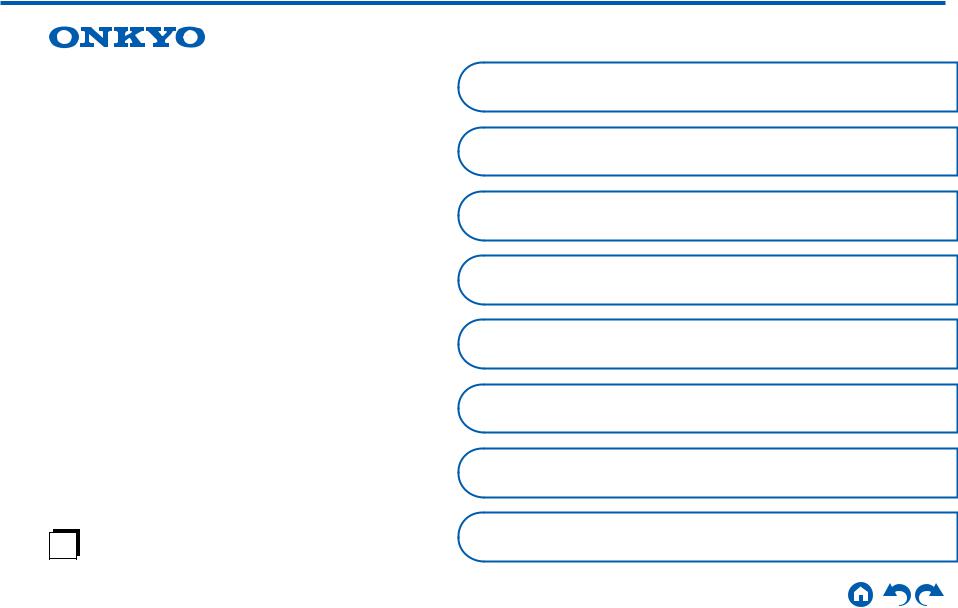
AV RECEIVER
TX-NR696
Instruction Manual
En
Table of contents |
|
|
Connections |
|
|
- Connecting Speakers |
|
|
Playback |
|
|
Setup |
|
|
Troubleshooting |
|
|
Appendix |
|
|
Supplementary Information |
|
|
Front Panel Rear Panel Remote |
|
|
|
|

Contents Connections Playback Setup
What’s in the box |
5 |
|
|
Connecting an Audio Component |
42 |
|
Additional Function (Firmware Update) |
6 |
|
|
Connecting a Video Camera, etc. |
43 |
|
Update Information of the firmware |
6 |
|
Connecting an AV Component in a Separate Room |
|
||
Operation of added new functions |
6 |
|
(Multi-zone Connection) |
44 |
||
Firmware Update Procedure |
7 |
|
|
Connecting a TV (ZONE 2) |
44 |
|
Part Names |
10 |
|
|
Connecting a Pre-main Amplifier (ZONE 2) |
45 |
|
Front Panel |
10 |
|
Connecting ZONE B |
46 |
||
Display |
12 |
|
|
Connecting a Pre-main Amplifier, etc. (ZONE B) |
46 |
|
Rear Panel |
13 |
|
Connecting Antennas |
47 |
||
Remote Controller |
16 |
|
Network Connection |
48 |
||
Connections |
|
|
Connecting the Power Cord |
49 |
||
|
|
|
|
Playback |
|
|
|
|
|
|
|||
Connecting speakers |
18 |
|
|
|||
|
|
|
|
|
||
Speaker Installation |
19 |
|
AV Component Playback |
51 |
||
Speaker Connections and "Speaker Setup" Settings |
25 |
|
|
Basic Operations |
51 |
|
Connecting a Power Amplifier |
|
|
BLUETOOTH® Playback |
52 |
||
(For European, Australian and Asian models only) |
35 |
|
|
Basic Operations |
52 |
|
Speaker combinations |
36 |
|
|
Internet Radio |
53 |
|
Connecting the TV |
38 |
|
|
Playing Back |
53 |
|
To ARC TV |
39 |
|
|
Spotify |
55 |
|
To Non-ARC TV |
40 |
|
|
AirPlay® |
56 |
|
Connecting Playback Devices |
41 |
|
|
Playing Back on This Unit |
56 |
|
Connecting an AV Component with HDMI Jack |
|
|
|
Playing Back on multiple devices (AirPlay2) |
57 |
|
Mounted |
41 |
|
DTS Play-Fi® |
58 |
||
|
2 |
|
|
|
||
|
|
Front Panel Rear Panel Remote |
|
|
||

Contents Connections Playback Setup
Playing Back
FlareConnectTM
Playing Back
USB Storage Device
Basic Operations
Device and Supported Format
Playing back files on a PC and NAS (Music Server)
Windows Media® Player settings Playing Back
Supported Audio Formats
Play Queue
Initial Setup
Adding Play Queue Information
Sort and Delete
Playing Back
Amazon Music
Registering This Unit with Amazon Music
Playing Amazon Music
Connecting the Sonos System for Playback
Necessary Equipment
How to Connect This Unit and Sonos Connect Setting Up
Playing Sonos on This Unit
58 |
Listening To the AM/FM Radio |
73 |
|||
59 |
|
Tuning into a Radio Station |
73 |
||
59 |
|
Presetting a Radio Station |
75 |
||
60 |
|
Using RDS (European, Australian and Asian models) |
77 |
||
60 |
Multi-zone |
78 |
|||
62 |
|
Playing Back |
79 |
||
63 |
ZONE B Playback |
81 |
|||
63 |
|
Playing Back |
81 |
||
64 |
Convenience functions |
82 |
|||
67 |
|
Displaying Your Favorite Video on TV While Playing |
|
||
68 |
|
Music |
82 |
||
68 |
|
Adjusting the tone |
83 |
||
68 |
|
Sleep Timer |
84 |
||
69 |
Listening Mode |
85 |
|||
69 |
|
Selecting a Listening mode |
85 |
||
70 |
|
Speaker Layouts and Selectable Listening Modes |
87 |
||
70 |
|
Listening Mode Effects |
90 |
||
70 |
|
Input Formats and Selectable Listening Modes |
96 |
||
71 |
|
Inputting Characters |
111 |
||
71 |
|
Setup |
|
||
71 |
|
|
|
|
|
Setup Menu |
112 |
||||
71 |
|
Menu list |
112 |
||
72 |
|
||||
|
Menu operations |
114 |
|||
|
|
||||
3 |
|
|
|
||
|
Front Panel Rear Panel Remote |
|
|
|
|

Contents Connections Playback Setup
1. |
Input/Output Assign |
115 |
2. |
Speaker |
118 |
3. Audio Adjust |
123 |
|
4. |
Source |
125 |
5. |
Hardware |
127 |
6. |
Multi Zone |
133 |
7. |
Miscellaneous |
133 |
Quick Menu |
135 |
|
Menu operations |
135 |
|
Web Setup |
137 |
|
Menu operations |
137 |
|
Initial Setup with Auto Start-up Wizard |
138 |
|
Operations |
138 |
|
Troubleshooting |
|
|
|
|
|
When the unit is operating erratically |
142 |
|
Troubleshooting |
144 |
|
Appendix |
|
|
|
|
|
Reducing the Power Consumption in Standby State |
153 |
|
About HDMI |
154 |
|
General Specifications |
156 |
|
4
Front Panel Rear Panel Remote
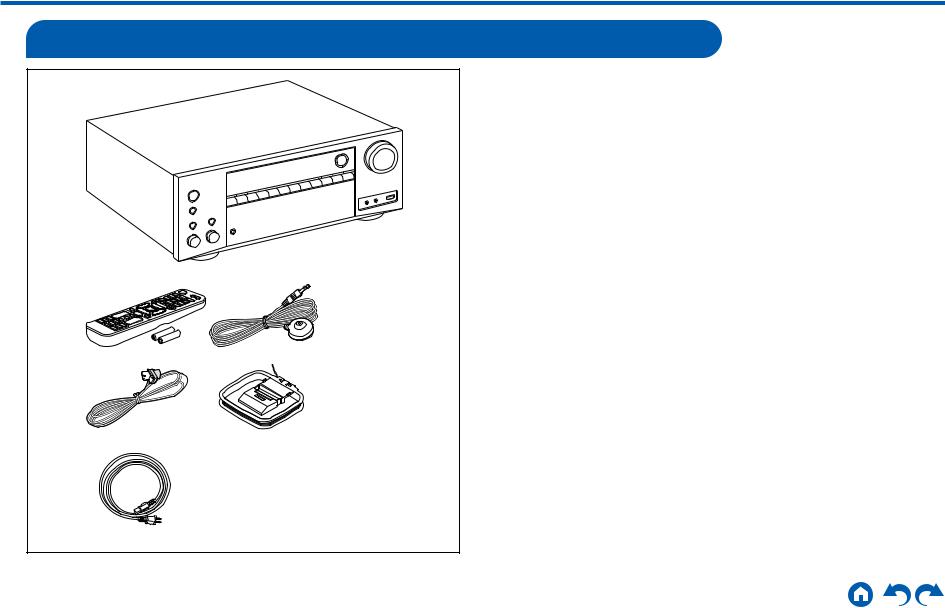
Contents Connections Playback Setup
What’s in the box
2 3
4  5
5
6
1.Main unit (1)
2.Remote controller (RC-972R) (1), Batteries (AAA/R03) (2)
3.Speaker setup microphone (1)
•Used during Initial Setup.
4.Indoor FM antenna (1)
5.AM loop antenna (1)
6.Power cord (European, Australian, Taiwanese and Asian models) (1)
• Quick Start Guide (1)
*This is an online user manual. This is not supplied with the product.
•Connect speakers with an impedance of 4 Ω to 16 Ω.
•The power cord must be connected only after all other connections are completed.
•We will not accept any responsibility for damage arising from the connection with equipment manufactured by other companies.
•Network services and content that can be used may no longer be available if new functions are added by updating firmware or the service providers terminate their services. Also, available services may differ depending on your area.
•Details on the firmware update will be posted on our website and through other means at a later date.
•The illustrations in this manual use those of North American models unless otherwise mentioned.
•Specifications and appearance are subject to change without prior notice.
5 |
Front Panel Rear Panel Remote |
|
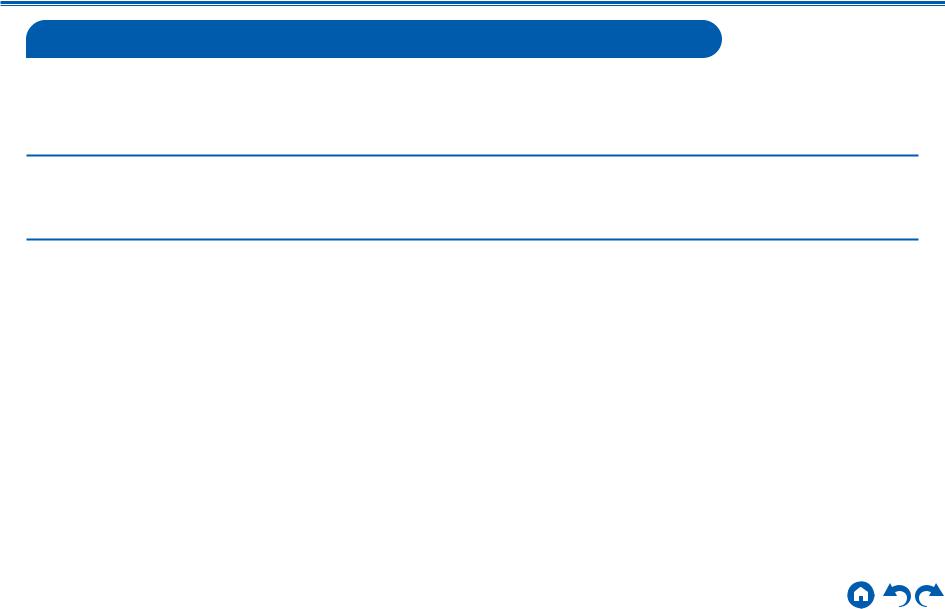
Contents Connections Playback Setup
Additional Function (Firmware Update)
This unit is equipped with a function to update the firmware via network or USB port when the firmware update is announced after purchase. This enables various functions to be added and operations to be improved.
Depending on the manufacturing timing of the product, the firmware may be switched to the updated one. In such a case, new functions may be added from the start. For how to confirm the latest firmware contents and the firmware version of your product, see the following section.
Update Information of the firmware
For the latest firmware contents and the firmware version, visit our company's website. If the firmware version of your product differs from the latest one, it is recommended to update the firmware.
To confirm the firmware version of your product, press the button on the remote controller, and refer to "7. Miscellaneous" - "Firmware Update" - "Version" (
button on the remote controller, and refer to "7. Miscellaneous" - "Firmware Update" - "Version" ( p134).
p134).
Operation of added new functions
If functions are added or changed from contents described in the Instruction Manual, see the following reference.
Supplementary Information
Firmware Update Procedure (  p7)
p7)
6 |
Front Panel Rear Panel Remote |
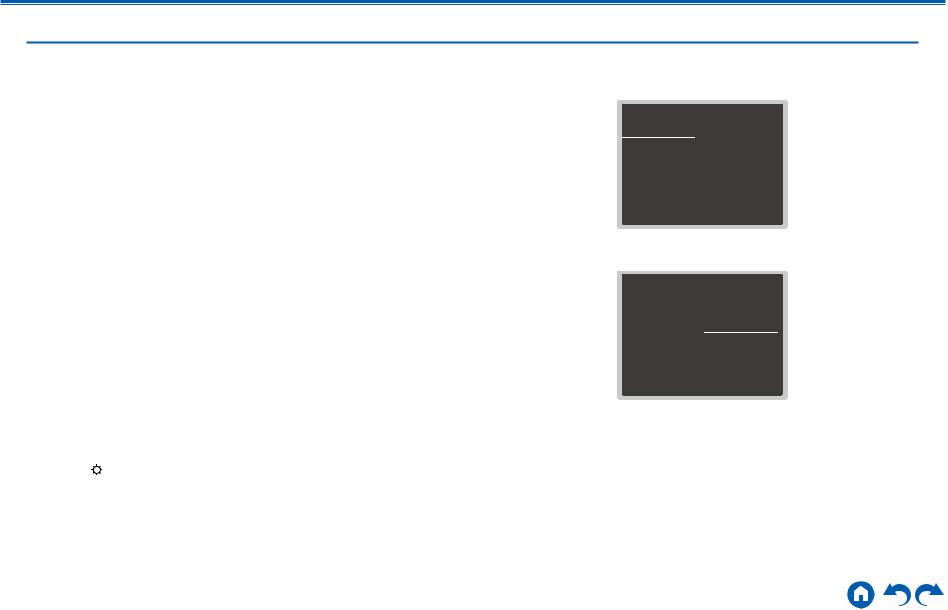
Contents Connections Playback Setup
Firmware Update Procedure
The update may take approx. 20 minutes to complete via network or via USB port. Existing settings are guaranteed in either updating method.
When this unit is connected to the network, notifications of firmware updates may be displayed. To update the firmware, select "Update Now" with the cursor buttons of the remote controller and press ENTER. The unit automatically enters standby mode after "Completed!" is displayed, and the update is completed.
Disclaimer: The program and accompanying online documentation are furnished to you for use at your own risk.
Our company will not be liable and you will have no remedy for damages for any claim of any kind whatsoever concerning your use of the program or the accompanying online documentation, regardless of legal theory, and whether arising in tort or contract.
In no event will our company be liable to you or any third party for any special, indirect, incidental, or consequential damages of any kind, including, but not limited to, compensation, reimbursement or damages on account of the loss of present or prospective profits, loss of data, or for any other reason whatsoever.
Updating the Firmware via Network
•While updating the firmware, do not do the following:
––Disconnecting and reconnecting cables, USB storage device, speaker setup microphone or headphones, or performing operations on the unit such as turning the power off
––Accessing this unit from a PC or smartphone using their applications
•Check that the unit is turned on, and the connection to the Internet is secured.
•Turn off control devices (PC etc.) connected to the network.
•Stop an Internet radio, USB storage device, or server content being played.
•If the multi-zone function is active, turn it off.
•If "HDMI CEC" is set to "On", set it to "Off".
––Press . Next, select "5. Hardware" - "HDMI" and press ENTER, then
select "HDMI CEC" and select "Off".
*The descriptions may differ from the actual on-screen displays, however, operations and functions are the same.
Update
1.Press .
.
The Setup menu is displayed on the TV screen.
Setup
1. |
Input/Output Assign |
1. TV Out / OSD |
|
2. |
Speaker |
2. |
HDMI Input |
3. Audio Adjust |
3. |
Digital Audio Input |
|
4. |
Source |
4. Analog Audio Input |
|
5.Hardware
6.Multi Zone
7.Miscellaneous
2.Select "7. Miscellaneous" - "Firmware Update" - "Update via NET" with the cursors in order, then press ENTER.
Setup
1. |
Input/Output Assign |
1. Tuner |
|
2. |
Speaker |
2. |
Remote ID |
3. Audio Adjust |
3. |
Firmware Update |
|
4. |
Source |
4. |
Initial Setup |
5. |
Hardware |
5. |
Lock |
6. |
Multi Zone |
6. |
Factory Reset |
7.Miscellaneous
•If "Firmware Update" is grayed out and cannot be selected, wait for a while until it starts up.
•If there is no updatable firmware, "Update via NET" cannot be selected.
3.Press ENTER with "Update" selected, and start update.
•During the update, the TV screen may go black depending on the program to be updated. In such a case, check the progress on the display of the unit. The TV screen will remain black until the update is completed and the power is turned on again.
•When "Completed!" is displayed, the update is complete.
7 |
Front Panel Rear Panel Remote |

Contents Connections Playback Setup
4.Press  ON/STANDBY on the main unit to turn the unit into standby mode. The process is completed, and your firmware is updated to the latest version.
ON/STANDBY on the main unit to turn the unit into standby mode. The process is completed, and your firmware is updated to the latest version.
•Do not use  on the remote controller.
on the remote controller.
If an Error Message is Displayed
If an error occurs, "- Error!" is displayed on the display of the unit. ("" represents an alphanumeric character.) Refer to the following descriptions and check.
Error Code
•-01, -10:
LAN cable not found. Connect the LAN cable properly.
•-02, -03, -04, -05, -06, -11, -13, -14, -16, -17, -18, -20, -21:
Internet connection error. Check the following:
––Whether the router is turned on
––Whether this unit and the router are connected via the network
Unplug and plug the power cords of this unit and the router. This may solve the problem. If you are still unable to connect to the Internet, the DNS server or proxy server may be temporarily down. Check the server operation status with your Internet service provider.
•Others:
After removing the power plug once, insert it to the outlet, and then start the operation from the beginning.
Updating via USB
•While updating the firmware, do not do the following:
––Disconnecting and reconnecting cables, USB storage device, speaker setup microphone or headphones, or performing operations on the unit such as turning the power off
––Accessing this unit from a PC or smartphone using their applications
•Prepare a 256 MB or larger USB storage device. The format of USB storage devices supports FAT16 or FAT32 file system format.
––Media inserted into a USB card reader may not be used for this function.
––USB storage devices equipped with the security function are not supported.
––USB hubs and USB devices equipped with the hub function are not supported. Do not connect these devices to the unit.
•Delete any data stored on the USB storage device.
•Turn off control devices (PC etc.) connected to the network.
•Stop an Internet radio, USB storage device, or server content being played
•If the multi-zone function is active, turn it off.
•If "HDMI CEC" is set to "On", set it to "Off".
––Press  . Next, select "5. Hardware" - "HDMI" and press ENTER, then
. Next, select "5. Hardware" - "HDMI" and press ENTER, then
select "HDMI CEC" and select "Off".
*Depending on the USB storage device or its content, long time may be required for loading, the content may not be loaded correctly, or power may not be supplied correctly.
*Our company will not be liable whatsoever for any loss or damage of data, or storage failure arising from the use of the USB storage device. Please note this in advance.
*The descriptions may differ from the actual on-screen displays, however, operations and functions are the same.
Update
1.Connect the USB storage device to your PC.
2.Download the firmware file from the our company's website to your PC and unzip.
Firmware files are named as below.
ONKAVR_R.zip
Unzip the file on your PC. The number of unzipped files and folders varies depending on the model.
3.Copy all unzipped files and folders to the root folder of the USB storage device.
•Make sure to copy the unzipped files.
4.Connect the USB storage device to the USB port of this unit.
•If an AC adapter is supplied with the USB storage device, connect the AC adapter, and use it with a household outlet.
•If the USB storage device has been partitioned, each section will be treated as an independent device.
8 |
Front Panel Rear Panel Remote |
|

Contents Connections Playback Setup
5.Press  .
.
The Setup menu is displayed on the TV screen.
Setup
1. |
Input/Output Assign |
1. TV Out / OSD |
|
2. |
Speaker |
2. |
HDMI Input |
3. Audio Adjust |
3. |
Digital Audio Input |
|
4. |
Source |
4. Analog Audio Input |
|
5.Hardware
6.Multi Zone
7.Miscellaneous
6.Select "7. Miscellaneous" - "Firmware Update" - "Update via USB" with the cursors in order, then press ENTER.
Setup
1. |
Input/Output Assign |
1. Tuner |
|
2. |
Speaker |
2. |
Remote ID |
3. Audio Adjust |
3. |
Firmware Update |
|
4. |
Source |
4. |
Initial Setup |
5. |
Hardware |
5. |
Lock |
6. |
Multi Zone |
6. |
Factory Reset |
7.Miscellaneous
•If "Firmware Update" is grayed out and cannot be selected, wait for a while until it starts up.
•If there is no updatable firmware, "Update via USB" cannot be selected.
7.Press ENTER with "Update" selected, and start update.
•During the update, the TV screen may go black depending on the program to be updated. In such a case, check the progress on the display of the unit. The TV screen will remain black until the update is completed and the power is turned on again.
•During the update, do not turn the power off, or disconnect or reconnect the USB storage device.
•When "Completed!" is displayed, the update is complete.
8.Disconnect the USB storage device from the unit.
9.Press  ON/STANDBY on the main unit to turn the unit into standby mode. The process is completed, and your firmware is updated to the latest version.
ON/STANDBY on the main unit to turn the unit into standby mode. The process is completed, and your firmware is updated to the latest version.
•Do not use  on the remote controller.
on the remote controller.
If an Error Message is Displayed
If an error occurs, "- Error!" is displayed on the display of the unit. ("" represents an alphanumeric character.) Refer to the following descriptions and check.
Error Code
•-01, -10:
The USB storage device cannot be recognized. Check if the USB storage device or USB cable is securely inserted to the USB port of the unit. Connect the USB storage device to an external power source if it has its own power supply.
•-05, -13, -20, -21:
The firmware file is not present in the root folder of the USB storage device, or the firmware file is for another model. Retry from the download of the firmware file.
•Others:
After removing the power plug once, insert it to the outlet, and then start the operation from the beginning.
9 |
Front Panel Rear Panel Remote |
|
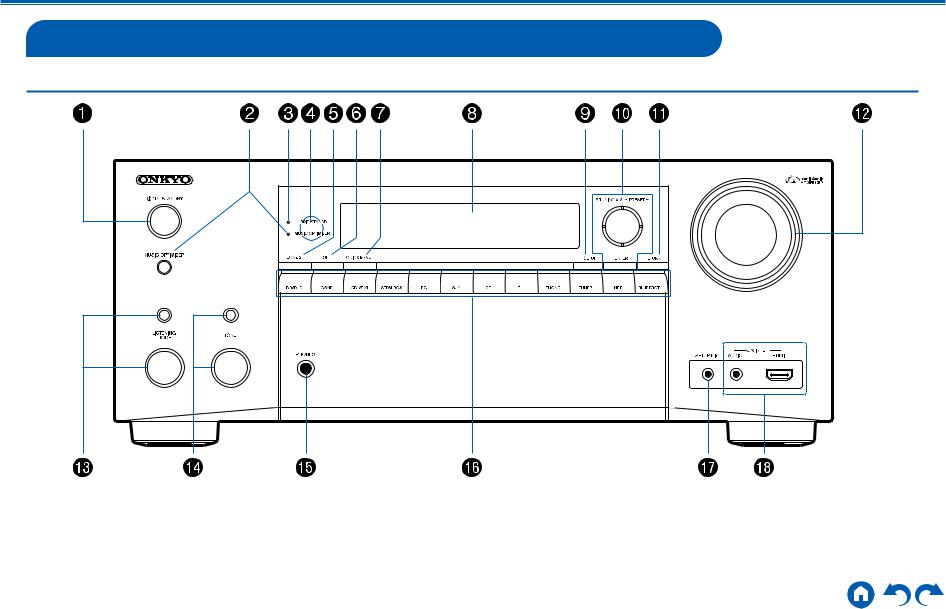
Contents Connections Playback Setup
Part Names
Front Panel
For details, see (  p11)
p11)
10 |
Front Panel Rear Panel Remote |

Contents Connections Playback Setup
1. ON/STANDBY button
ON/STANDBY button
2.MUSIC OPTIMIZER button/indicator (North American models): Turns on/off the MUSIC OPTIMIZER function that improves the quality of the compressed audio.
PURE AUDIO button/indicator (European, Australian, Taiwanese and Asian models): Switches to the Pure Audio mode. (  p93)
p93)
3.HYBRID STANDBY indicator: Lights up when any of the following functions is working or enabled in standby state of this unit. When this indicator is lighting, the power consumption in standby state increases, however, the increase in power consumption is minimized by entering the HYBRID STANDBY mode where only the essential circuits operate.
––HDMI CEC (  p127)
p127)
––HDMI Standby Through (  p127)
p127)
––USB Power Out at Standby (  p131)
p131)
––Network Standby (  p131)
p131)
––Bluetooth Wakeup (  p132)
p132)
4.Remote control sensor: Receives signals from the remote controller.
•The reception range of the remote controller is within a distance of approx. 16´/5 m, and an angle of 20° in vertical direction and 30° to right and left.
5.ZONE 2 button: Controls the multi-zone function. (  p79)
p79)
6.OFF button: Switches the multi-zone function off. (  p79)
p79)
7.QUICK MENU button: Pressing this button during playback can make settings such as "HDMI" and "Audio" quickly on the TV screen while playing.
(  p135)
p135)
8.Display (  p12)
p12)
9.SETUP button: You can display advanced setting items on the TV and the display to have a more enjoyable experience with this unit. (  p112)
p112)
10.Cursor buttons ( /
/  /
/  /
/  ) and ENTER button: Select an item with the cursors, and press ENTER to confirm your selection. When using TUNER, use them to tune in to stations. (
) and ENTER button: Select an item with the cursors, and press ENTER to confirm your selection. When using TUNER, use them to tune in to stations. (  p73)
p73)
11.RETURN button: Returns the display to the previous state while setting.
12.MASTER VOLUME
13.Press the LISTENING MODE button (above) to select a category from "Movie/ TV", "Music" and "Game", and then turn the LISTENING MODE dial (below) to change the listening mode (  p85).
p85).
14.Adjusts the sound quality. Press the TONE button (above) to select an item to adjust from "Bass", "Vocal" and "Treble", and turn the TONE dial (below) to
adjust. (  p83)
p83)
15.PHONES jack: Connect headphones with a standard plug (ø1/4″/6.3 mm).
16.Input selector buttons: Switches the input to be played.
17.SETUP MIC jack: Connect the supplied speaker setup microphone. (  p139)
p139)
18.AUX INPUTAUDIO/HDMI jack: Connect a video camera, etc. using a stereo mini plug cable (ø1/8″/3.5 mm) or HDMI cable. (  p43)
p43)
11 |
Front Panel Rear Panel Remote |
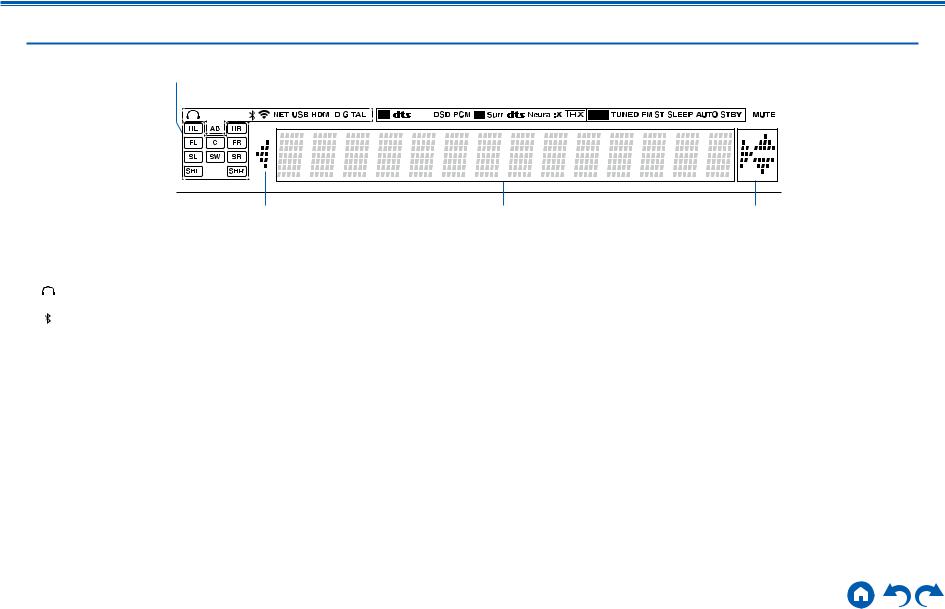
Contents Connections Playback Setup
Display
1 |
2 |
|
3 |
4 |
5 |
|||||||||
|
|
|
|
|
|
|
|
|
|
|
|
|
|
|
|
|
|
|
|
|
|
|
|
|
|
|
|
|
|
|
|
|
|
|
|
|
|
|
|
|
|
|
|
|
|
|
|
|
|
|
|
|
|
|
|
|
|
|
|
|
|
|
|
|
|
|
|
|
|
|
|
|
|
|
7 |
6 |
7 |
1.Speaker/Channel display: Displays the output channel that corresponds to the selected listening mode.
2.Lights in the following conditions.
:Headphones are connected.
Z2: ZONE 2 is on.
: Connected by BLUETOOTH.
 : Connected by Wi-Fi.
: Connected by Wi-Fi.
NET: Lights when connected to the network with the "NET" input selector. It will blink if incorrectly connected to the network.
USB: Lights when the "NET" input selector is selected, a USB device is connected and the USB input is selected. It will blink if the USB device is not properly connected.
HDMI: HDMI signals are input and the HDMI input is selected.
DIGITAL: Digital signals are input and the digital input is selected.
A:Audio in output only to ZONE A.
B:Audio is output only to ZONE B.
AB: Audio is output to both ZONE A and ZONE B.
3.Lights according to the type of input digital audio signal and the listening mode.
4.Lights in the following conditions.
RDS (European, Australian and Asian models): Receiving RDS broadcasting.
TUNED: Receiving AM/FM radio.
FM ST: Receiving FM stereo.
SLEEP: Sleep timer is set. (  p131)
p131)
AUTO STBY: Auto Standby is set. (  p131)
p131)
5.Blinks when muting is on.
6.Displays various information of the input signals.
•"DialogNorm: X dB" ("X" is a numerical value) may be displayed when software recorded in Dolby lineage or DTS lineage audio formats is played. For example, if "DialogNorm: +4 dB" is displayed, the source being played is recorded with 4 dB plus the THX standard level. If you play it with the THX standard level, lower the volume by 4 dB.
7.This may light when operating with the "NET" input selector.
12 |
Front Panel Rear Panel Remote |
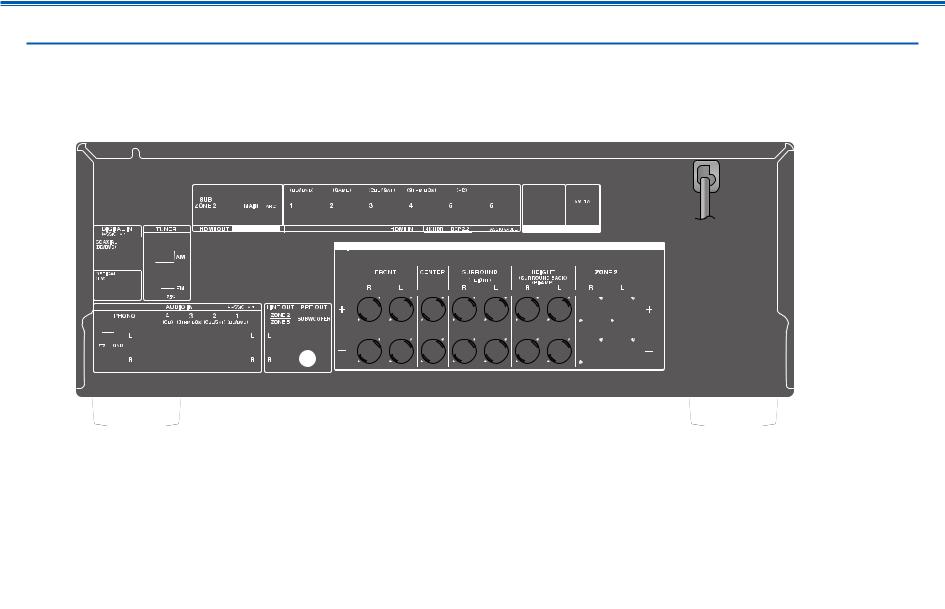
Contents Connections Playback Setup
Rear Panel
(North American and Taiwanese models)
90°
(Taiwanese models)
For details, see (  p15)
p15)
13 |
Front Panel Rear Panel Remote |
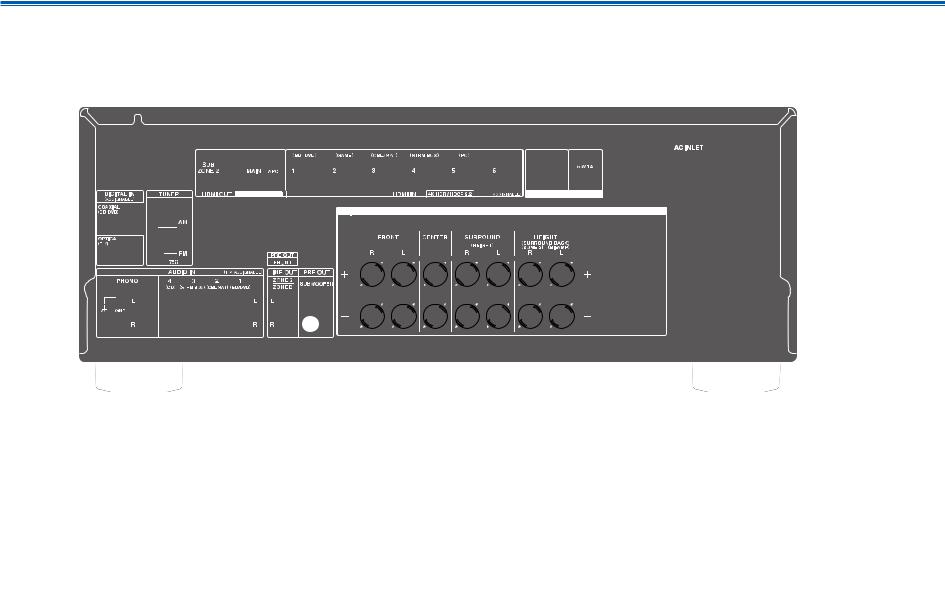
Contents Connections Playback Setup
(European, Australian and Asian models)
90°
For details, see (  p15)
p15)
14 |
Front Panel Rear Panel Remote |

Contents Connections Playback Setup
1.DIGITAL IN OPTICAL/COAXIAL jacks: Input TV or AV component digital audio signals with a digital optical cable or digital coaxial cable.
2.TUNER AM/FM terminal: Connect the supplied antennas.
3.HDMI OUT jacks: Transmit video signals and audio signals with an HDMI cable connected to a monitor such as a TV or projector.
4.Wireless antenna: Used for WI-Fi connection or when using a BLUETOOTHenabled device. Adjust the angles according to the connection status.
5.HDMI IN jacks: Transmit video signals and audio signals with an HDMI cable connected to an AV component.
6.ETHERNET port: Connect to the network with a LAN cable.
7.USB port: Connect a USB storage device to play music files. (  p60) You can also supply power (5 V/1 A) to USB devices with a USB cable.
p60) You can also supply power (5 V/1 A) to USB devices with a USB cable.
8.Power cord (North American models)
AC INLET (European, Australian, Taiwanese and Asian models): Connect the supplied power cord.
9.GND terminal: Connect the ground wire of the turntable.
10.AUDIO IN jacks: Input AV component audio signals with an analog audio cable.
11.ZONE 2 LINE OUT jacks: Output audio signals with an analog audio cable connected to a pre-main amplifier in a separate room (ZONE 2).
ZONE B LINE OUT jacks: Connect to a pre-main amplifier with an analog audio cable, and simultaneously output audio of the same source as that of the speakers (ZONE A) connected to this unit.
PRE OUT FRONT jacks (European, Australian and Asian models): Connect to a power amplifier. (  p35)
p35)
12.SUBWOOFER PRE OUT jacks: Connect a powered subwoofer with a subwoofer cable. Up to two powered subwoofers can be connected. The same signal is output from each SUBWOOFER PRE OUT jack.
13.SPEAKERS terminals: Connect speakers with speaker cables. (North
American models support banana plugs. Use a plug 4 mm in diameter. Y plug connection is not supported.)
15 |
Front Panel Rear Panel Remote |
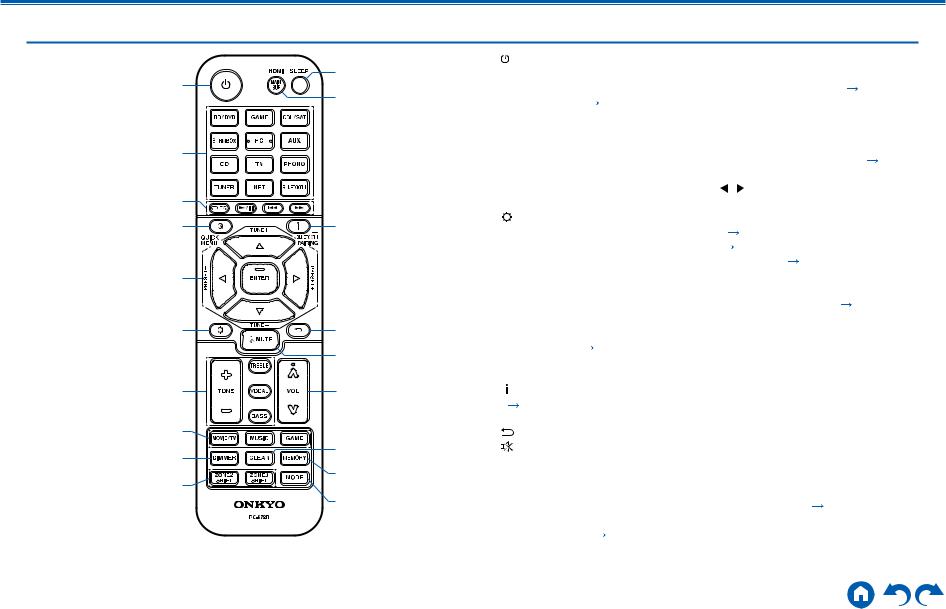
Contents Connections Playback Setup
Remote Controller
|
|
1. |
ON/STANDBY button |
|
|
|
|
2. |
Input selector buttons: Switches the input to be played. |
p63) |
|||
|
3. |
Play buttons: Used for playback operations for the Music Server ( |
||||
|
|
or USB device ( |
p60). Also, switching to "CEC MODE" with "19. MODE |
|||
|
|
|
button" allows you to operate an HDMI CEC function-enabled AV component. |
|||
|
|
|
(Some devices may not be operated.) |
|
|
|
|
|
4. |
Q (QUICK MENU) button: Pressing this button during playback allows you to make |
|||
|
|
settings such as "HDMI" and "Audio" quickly on the TV screen while playing.( p135) |
||||
|
|
|
||||
|
|
5. |
Cursor buttons and ENTER button: Select an item with the cursors, and press |
|||
|
|
|
ENTER to confirm your selection. Pressing |
/ button allows you to switch the |
||
|
6. |
screen when a music folder list or file list is not displayed on one screen on the TV. |
||||
|
|
button: Displays advanced setting items on the TV or the display to have a |
||||
|
more enjoyable experience with this unit. ( |
p112) |
|
|||
|
|
7. |
TONE button: Adjusts the sound quality. ( |
p83) |
|
|
|
|
8. |
LISTENING MODE button: Selects a listening mode ( p85). |
|
||
|
|
9. |
DIMMER button: Switches the brightness of the display with three levels. It |
|||
|
|
|
cannot be turned off completely. |
|
p78). |
|
|
|
10. |
ZONE 2 SHIFT button: Used to control the multi-zone function ( |
|||
|
|
|
(The ZONE 3 SHIFT button cannot be used with this unit.) |
|
||
11. |
SLEEP button: Sets the sleep timer. Select the time from "30 min", "60 min" |
|||||
|
|
|
and "90 min". ( |
p84) |
|
|
|
12. |
HDMI MAIN/SUB button: Select the HDMI OUT jack to output video signals |
||||
|
|
|||||
|
|
|
from "MAIN", "SUB", and "MAIN+SUB". |
|
|
|
13. |
button: Switches the information on the display and is used to operate RDS |
|||||
|
|
|
( p77). Also, when the "BLUETOOTH" input selector is selected, pressing |
|||
|
|
|
and holding this button for 5 seconds or more will switch to the pairing mode. |
|||
|
14. |
button: Returns the display to the previous state while setting. |
|
|||
|
15. |
button: Temporarily mutes audio. Press the button again to cancel muting. |
||||
|
16. |
VOLUME buttons |
|
|
||
|
17.CLEAR button: Deletes all characters you have entered when entering text on |
|||||
|
|
the TV screen. |
|
|
|
|
|
18. |
MEMORY button: Used to register AM/FM radio stations. ( p75) |
|
|||
|
|
19. |
MODE button: Switches between automatic tuning and manual tuning for |
|||
|
|
|
AM/FM stations ( p73). Also, when an HDMI CEC function-enabled AV |
|||
|
|
|
component is connected to this unit, you can switch "3. Play buttons" between |
|||
|
|
|
"CEC MODE" and "RCV MODE" (normal mode). |
|
||
|
|
16 |
|
Front Panel Rear Panel Remote |
|
|
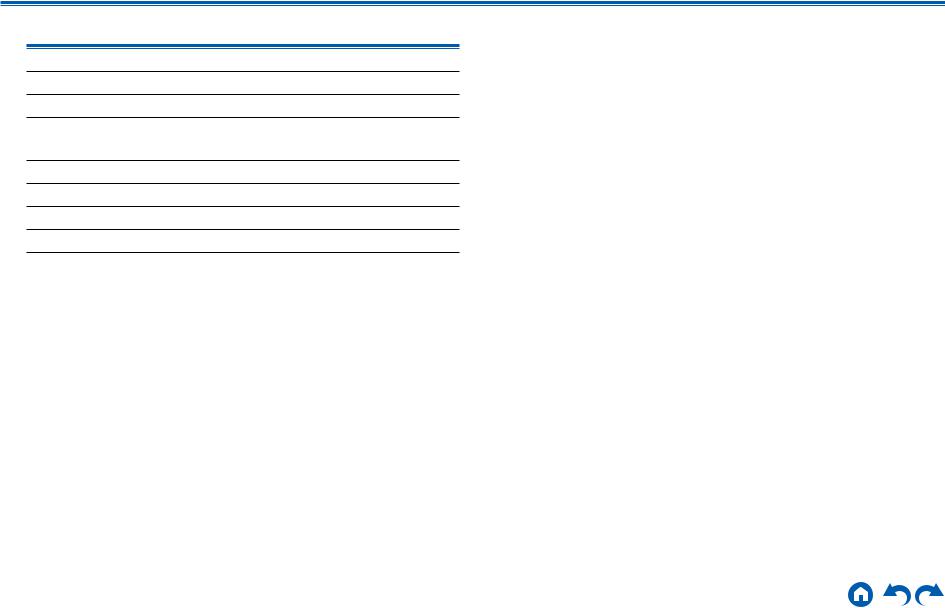
Contents Connections Playback Setup
Connections
Connecting speakers |
18 |
Connecting the TV |
38 |
Connecting Playback Devices |
41 |
Connecting an AV Component in a Separate Room |
|
(Multi-zone Connection) |
44 |
Connecting ZONE B |
46 |
Connecting Antennas |
47 |
Network Connection |
48 |
Connecting the Power Cord |
49 |
17 |
Front Panel Rear Panel Remote |
|
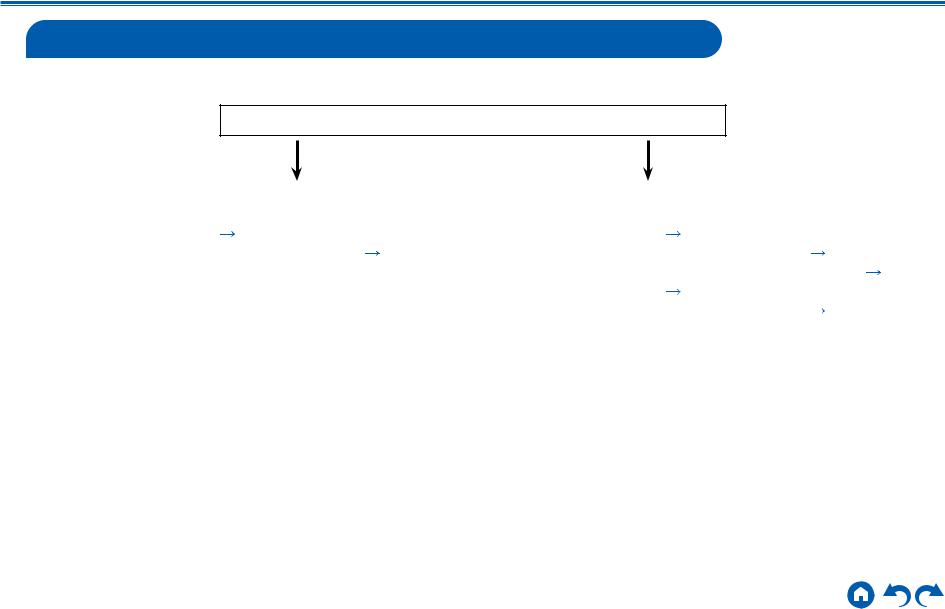
Contents Connections Playback Setup
Connecting speakers
You can select the layout of speakers to be installed from various patterns when using this unit. Use the following flow chart to select the speaker layout that suits your speakers and usage environment. You can check the connection method and default settings.
Use height speakers?
Yes |
|
|
|
No |
|
|
|
|
|
|
|
• 5.1.2 Channel System ( p33) |
|
• 5.1 |
Channel System ( |
p27) |
|
• 5.1.2 Channel System + ZONE SPEAKER ( p34) |
|
• 5.1 Channel System + ZONE SPEAKER ( |
p28, 29) |
||
|
|
• 5.1 |
Channel System (Bi-Amping the Speakers) ( p30) |
||
|
|
• 7.1 |
Channel System ( |
p31) |
|
|
|
• 7.1 Channel System + ZONE SPEAKER ( |
p32) |
||
18 |
Front Panel Rear Panel Remote |
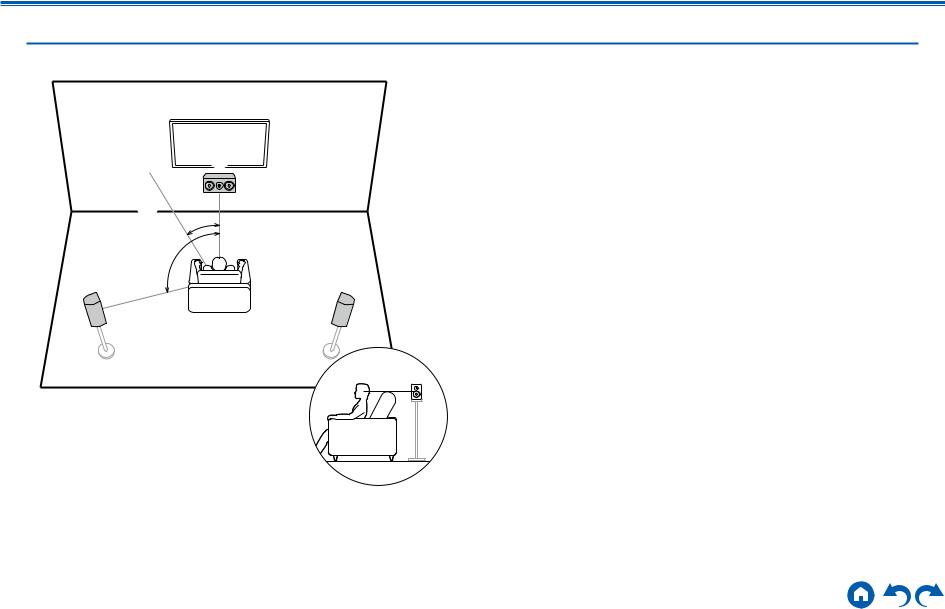
Contents Connections Playback Setup
Speaker Installation
5.1 Channel System
2 3
3  1
1
6 a
a
b
5 4
This is a basic 5.1 Channel System. Front speakers output the front stereo sound, and a center speaker outputs the sound of the center of the screen, such as dialogs and vocals. Surround speakers create the back sound field. Powered subwoofer reproduces the bass sound, and creates the rich sound field.
The front speakers should be positioned at ear height while the surround speakers should be positioned just above ear height. The center speaker should be set up facing the listening position at an angle. Placing the powered subwoofer between the center speaker and the front speaker gives you a natural sound even when playing music sources.
1,2 Front Speakers
3 Center Speaker
4,5 Surround Speakers
6Powered Subwoofer
a: 22° to 30°, b: 120°
Speaker Layouts and Selectable Listening
Modes (  p87)
p87)
19 |
Front Panel Rear Panel Remote |

Contents Connections Playback Setup
7.1 Channel System
2 3
3  1
1
6 a
a
|
b |
5 |
4 |
|
c |
 8
8
a: 22° to 30°, b: 90° to 110°, c: 135° to 150°
7 |
This is a 7.1 Channel System that consists of the basic 5.1 Channel System
(  p19) and added surround back speakers. Front speakers output the
p19) and added surround back speakers. Front speakers output the
front stereo sound, and a center speaker outputs the sound of the center of the screen, such as dialogs and vocals. Surround speakers create the back sound field. Powered subwoofer reproduces the bass sound, and creates the rich sound field. Surround back speakers improves the sense of envelopment and connectivity of sound in the back sound field, and provides a more real sound field.
The front speakers should be positioned at ear height while the surround speakers should be positioned just above ear height. The center speaker should be set up facing the listening position at an angle. Placing the powered subwoofer between the center speaker and the front speaker gives you a natural sound even when playing music sources. The surround back speakers should be positioned at ear height.
•If surround back speakers are installed, be sure to install surround speakers as well.
1,2 Front Speakers
3 Center Speaker
4,5 Surround Speakers
6Powered Subwoofer
7,8 Surround Back Speakers
Speaker Layouts and Selectable Listening
Modes (  p87)
p87)
20 |
Front Panel Rear Panel Remote |

Contents Connections Playback Setup
5.1.2 Channel System
A 5.1.2 Channel System is a speaker layout consisting of the basic 5.1 Channel System (  p19) and added height speakers. Select the height speakers that suit your speakers and usage environment from the following three types.
p19) and added height speakers. Select the height speakers that suit your speakers and usage environment from the following three types.
Front High Speakers/Rear High Speakers
Installation Example (  p22)
p22)
Ceiling Speakers Installation Example
(  p23)
p23)
Dolby Enabled Speakers (Dolby Speakers)
Installation Example (  p24)
p24)
21 |
Front Panel Rear Panel Remote |
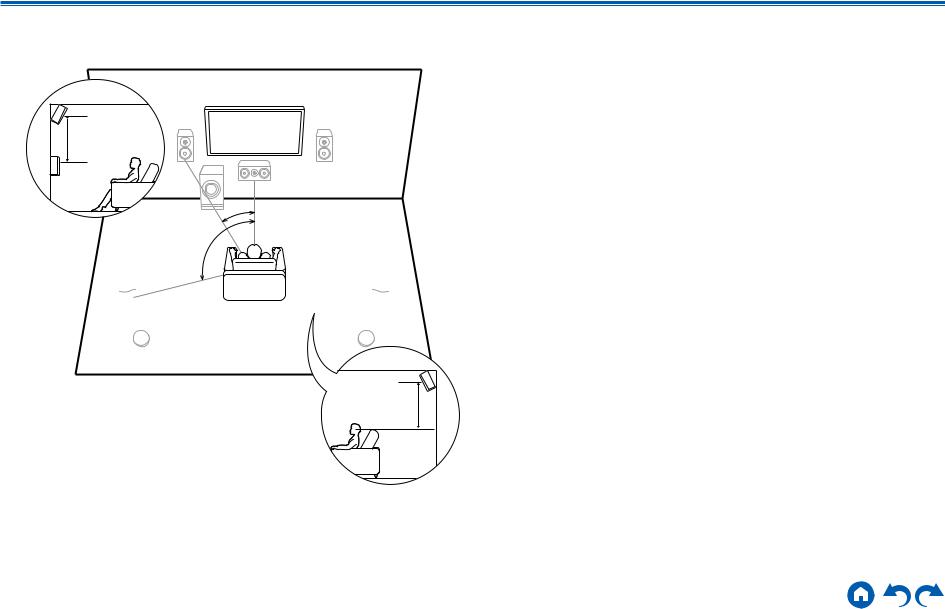
Contents Connections Playback Setup
Front High Speakers/Rear High Speakers
Installation Example
8
 7
7
3´ (0.9 m) or more
a
b
This is a system with the basic 5.1 channel system (  p19) consisting of front speakers, a center speaker, surround speakers and a powered subwoofer, and added front high speakers or rear high speakers combined. Installing the height speakers will enrich the sound field feeling in the upper space. Front high speakers or rear high speakers should be installed at least 3´/0.9 m higher than the front speakers.
p19) consisting of front speakers, a center speaker, surround speakers and a powered subwoofer, and added front high speakers or rear high speakers combined. Installing the height speakers will enrich the sound field feeling in the upper space. Front high speakers or rear high speakers should be installed at least 3´/0.9 m higher than the front speakers.
Front high speakers should be installed directly above the front speakers, and the distance between the rear high speakers should match the distance between the front speakers. In both cases, the speakers should be set up facing the listening position at an angle.
7,8 Height Speakers Choose one of the following:
•Front High Speakers
•Rear High Speakers
 8
8
a: 22° to 30°, b: 120°
 7
7
3´ (0.9 m) |
or more |
Speaker Layouts and Selectable Listening
Modes (  p87)
p87)
22 |
Front Panel Rear Panel Remote |
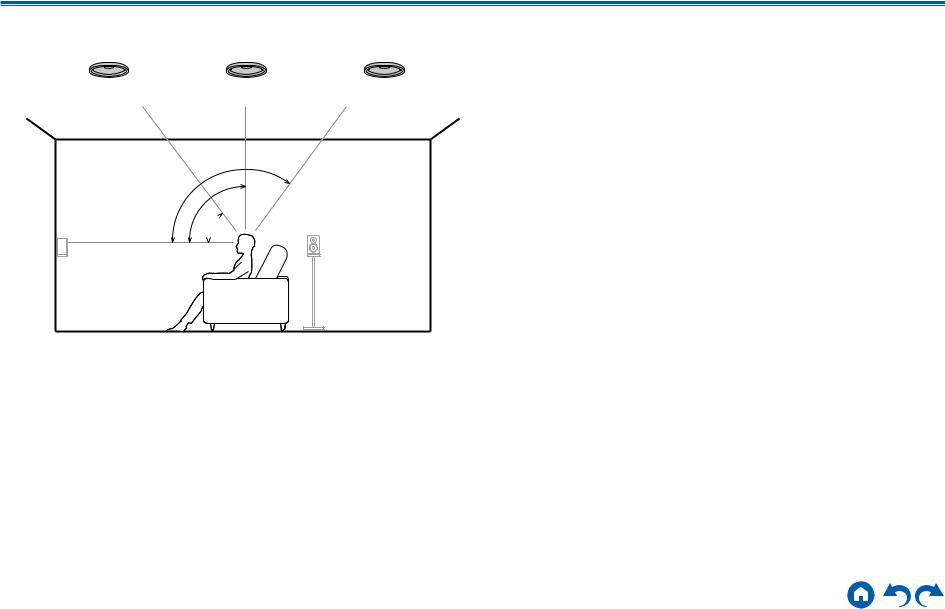
Contents Connections Playback Setup
Ceiling Speakers Installation Example
8 8 8
7 7
7 7
7
c
b
a
a: 30° to 55°, b: 65° to 100°, c: 125° to 150°
This is a system with the basic 5.1 channel system (  p19) consisting of front speakers, a center speaker, surround speakers and a powered subwoofer, and added top front speakers or top middle speakers or top rear speakers combined.
p19) consisting of front speakers, a center speaker, surround speakers and a powered subwoofer, and added top front speakers or top middle speakers or top rear speakers combined.
Installing the height speakers will enrich the sound field feeling in the upper space. Install the top front speakers on the ceiling anterior to the seating position, top middle speakers on the ceiling directly above the seating position, and top rear speakers on the ceiling posterior to the seating position. The distance between each pair should match the distance between the front speakers.
•Dolby Laboratories recommends the setups of these types of height speakers to obtain the best Dolby Atmos effect.
7,8 Height Speakers Choose one of the following:
•Top Front Speakers
•Top Middle Speakers
•Top Rear Speakers
Speaker Layouts and Selectable Listening
Modes (  p87)
p87)
23 |
Front Panel Rear Panel Remote |
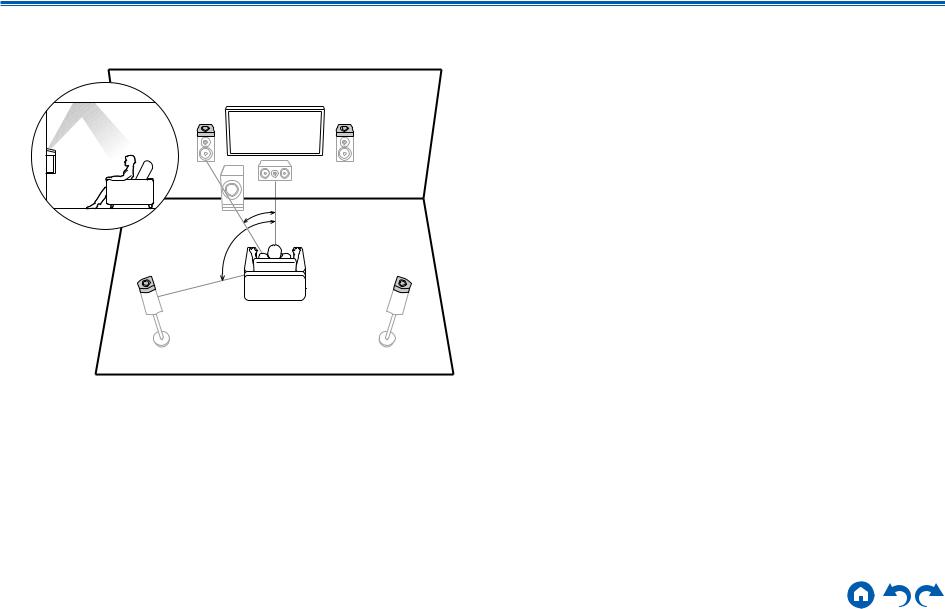
Contents Connections Playback Setup
Dolby Enabled Speakers (Dolby Speakers)
Installation Example
8 |
7 |
|
a |
|
b |
8 |
7 |
a: 22° to 30°, b: 120°
This is a system with the basic 5.1 channel system (  p19) consisting of front speakers, a center speaker, surround speakers and a powered subwoofer, and added Dolby enabled speakers (front) or Dolby enabled speakers (surround) combined. Dolby enabled speakers are special speakers designed to face the ceiling, so that the sound is heard from overhead by bouncing the sound off the ceiling. Installing the height speakers will enrich the sound field feeling in the upper space.
p19) consisting of front speakers, a center speaker, surround speakers and a powered subwoofer, and added Dolby enabled speakers (front) or Dolby enabled speakers (surround) combined. Dolby enabled speakers are special speakers designed to face the ceiling, so that the sound is heard from overhead by bouncing the sound off the ceiling. Installing the height speakers will enrich the sound field feeling in the upper space.
Install them either on the front speakers or on the surround speakers.
7,8 Height Speakers Choose one of the following:
•Dolby Enabled Speakers (Front)
•Dolby Enabled Speakers (Surround)
Speaker Layouts and Selectable Listening
Modes (  p87)
p87)
24 |
Front Panel Rear Panel Remote |
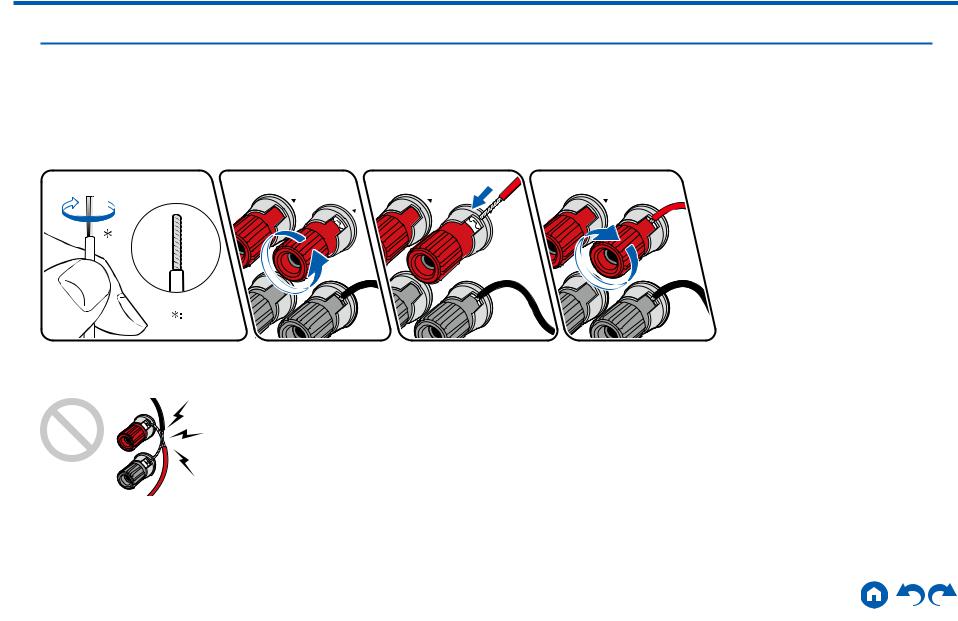
Contents Connections Playback Setup
Speaker Connections and "Speaker Setup" Settings
Connections
(Note) Speaker Impedance
Connect speakers with an impedance of 4 Ω to 16 Ω. If any of the speakers to be connected has an impedance of 4 Ω or more and less than 6 Ω, set "Speaker
Impedance" to "4ohms" for "Speaker Setup" in the Initial Setup section (  p138). When setting "Speaker Impedance" from the Setup menu, press
p138). When setting "Speaker Impedance" from the Setup menu, press  on the remote controller, and set "2. Speaker" - "Configuration" - "Speaker Impedance" (
on the remote controller, and set "2. Speaker" - "Configuration" - "Speaker Impedance" (  p119) to "4ohms".
p119) to "4ohms".
Connect the Speaker Cables
1/2˝
(12 mm)
Make correct connection between the unit's jacks and speaker's jacks (+ side to + side, and - side to - side) for each channel. If the connection is wrong, a bass sound will not be reproduced properly due to reverse phase. Twist the wires exposed from the tip of the speaker cable so that the wires do not stick out of the speaker terminal when connecting. If the exposed wires touch the rear panel, or the + side and – side wires touch each other, a malfunction may occur.
25 |
Front Panel Rear Panel Remote |
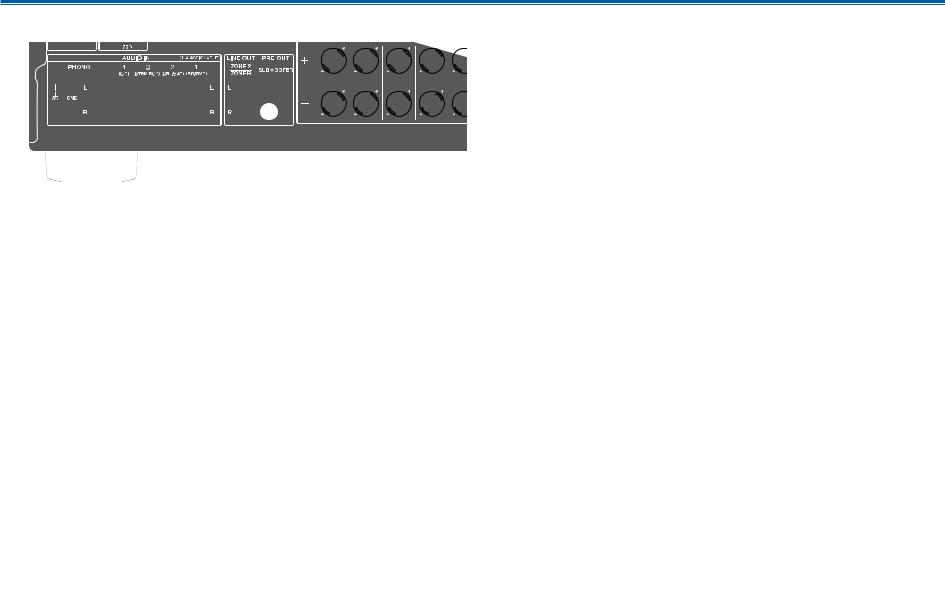
Contents Connections Playback Setup
Connect the Subwoofer
a
a Subwoofer cable
Connect a powered subwoofer with this unit using a subwoofer cable. Up to two powered subwoofers can be connected. The same signal is output from each SUBWOOFER PRE OUT jack.
26 |
Front Panel Rear Panel Remote |
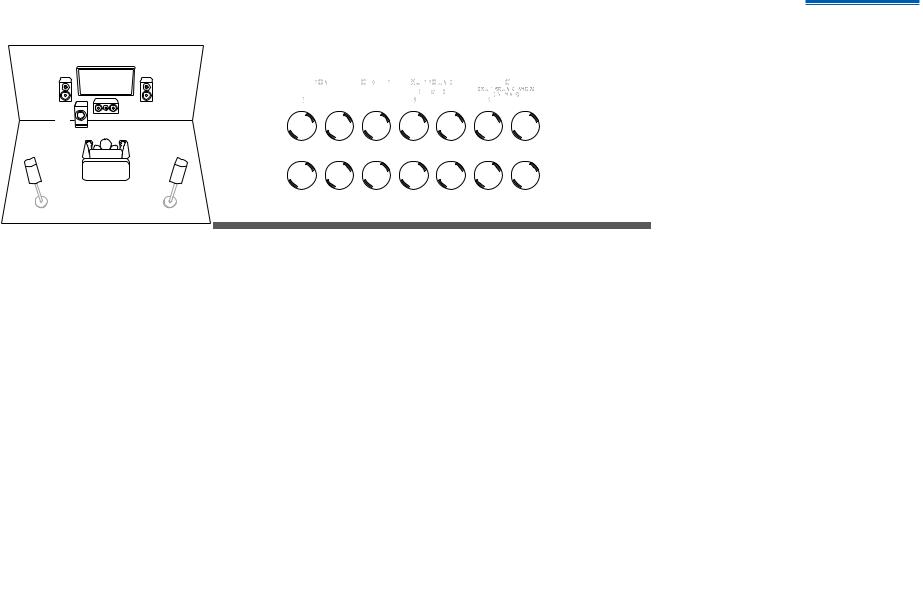
Contents Connections Playback Setup
5.1 Channel System
2 |
3 |
1 |
6 |
|
|
5 |
|
4 |
This is a basic 5.1 Channel System. For details of the speaker layout, refer to "Speaker Installation" (  p19).
p19).
"Speaker Setup" settings during Initial Setup (  p139)
p139)
Speaker Setup
Speaker Channels |
5.1 ch < > |
|
|
Subwoofer |
Yes |
|
|
Height Speaker |
--- |
|
|
|
|
||
Zone Speaker |
No |
|
|
Zone 2 Lineout |
Zone 2 |
|
|
Bi-Amp |
No |
|
|
Speaker Impedance 6ohms or above
Select how many speakers you have.
 Next
Next
•Speaker Channels: 5.1 ch
•Subwoofer: Yes
•Height Speaker: ---
•Zone Speaker: No
•Zone 2 Lineout/(Preout): Any
value ( p119)
•Bi-Amp: No
•Speaker Impedance: Any value
( p25)
27 |
Front Panel Rear Panel Remote |
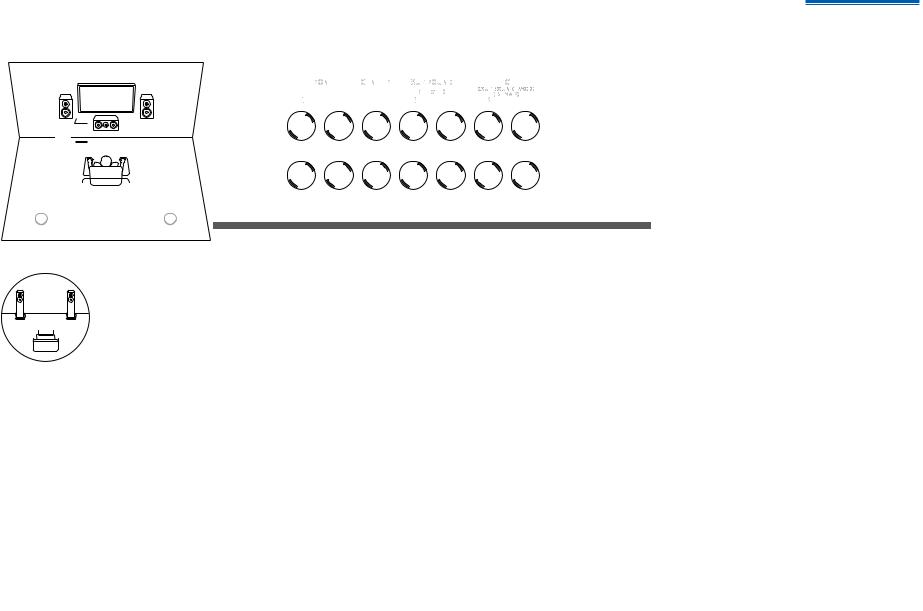
Contents Connections Playback Setup
5.1 Channel System + ZONE SPEAKER (North American and Taiwanese models)
MAIN ROOM
"Speaker Setup" settings during Initial Setup (  p139)
p139)
2 3 1
6
5

 4
4
ZONE 2
8

 7
7
MAIN ROOM: This is a basic 5.1 Channel System. For details of the speaker layout, refer to "Speaker Installation" (  p19).
p19).
ZONE 2: You can enjoy 2-ch audio in the separate room (ZONE 2) while performing 5.1-ch playback in the main room (where this unit is located). The same source can be played back in the main room and ZONE 2 simultaneously. Also, different sources can be played back in both rooms.
Speaker Setup
Speaker Channels |
5.1 ch < > |
|
|
|
Subwoofer |
Yes |
|
|
|
Height Speaker |
--- |
|
|
|
|
|
|||
Zone Speaker |
Zone 2 |
|
|
|
Zone 2 Lineout |
|
|
|
|
Zone 2 |
|
|
||
Bi-Amp |
No |
|
|
|
Speaker Impedance 6ohms or above
Select how many speakers you have.
 Next
Next
•Speaker Channels: 5.1 ch
•Subwoofer: Yes
•Height Speaker: ---
•Zone Speaker: Zone 2
•Zone 2 Lineout/(Preout): Zone 2
•Bi-Amp: No
•Speaker Impedance: Any value
( p25)
Setup
When video and audio via HDMI input are output to ZONE 2, set "1. Input/Output Assign" - "TV Out /
OSD" - "Zone 2 HDMI" ( p115) to "Use" on the Setup menu.
28 |
Front Panel Rear Panel Remote |
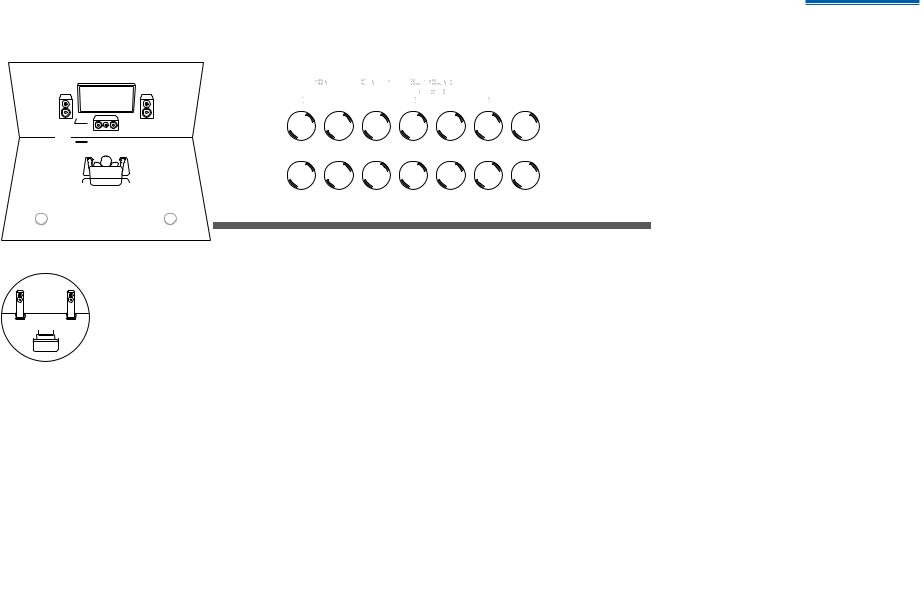
Contents Connections Playback Setup
5.1 Channel System + ZONE SPEAKER (European, Australian and Asian models)
MAIN ROOM
"Speaker Setup" settings during Initial Setup (  p139)
p139)
2 3 1
6
5

 4
4
ZONE 2
8

 7
7
MAIN ROOM: This is a basic 5.1 Channel System. For details of the speaker layout, refer to "Speaker Installation" (  p19).
p19).
ZONE 2: You can enjoy 2-ch audio in the separate room (ZONE 2) while performing 5.1-ch playback in the main room (where this unit is located). The same source can be played back in the main room and ZONE 2 simultaneously. Also, different sources can be played back in both rooms.
Speaker Setup
Speaker Channels |
5.1 ch < > |
|
|
|
Subwoofer |
Yes |
|
|
|
Height Speaker |
--- |
|
|
|
|
|
|||
Zone Speaker |
Zone 2 |
|
|
|
Zone 2 Lineout |
|
|
|
|
Zone 2 |
|
|
||
Bi-Amp |
No |
|
|
|
Speaker Impedance 6ohms or above
Select how many speakers you have.
 Next
Next
•Speaker Channels: 5.1 ch
•Subwoofer: Yes
•Height Speaker: ---
•Zone Speaker: Zone 2
•Zone 2 Lineout/(Preout): Zone 2
•Bi-Amp: No
•Speaker Impedance: Any value
( p25)
Setup
When video and audio via HDMI input are output to ZONE 2, set "1. Input/Output Assign" - "TV Out /
OSD" - "Zone 2 HDMI" ( p115) to "Use" on the Setup menu.
29 |
Front Panel Rear Panel Remote |
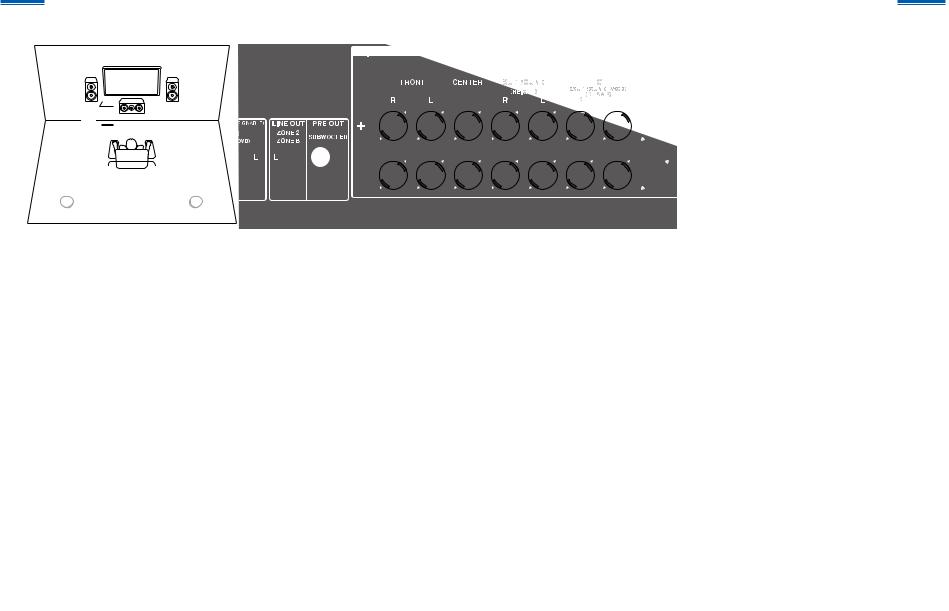
Contents Connections Playback Setup
5.1 Channel System (Bi-Amping the Speakers)
2 3 1
6
5

 4
4 



 For highfrequency
For highfrequency
For lowfrequency
You can configure a 5.1 Channel System ( p19) by connecting front speakers that support Bi-Amping connection. The Bi-Amping connection can improve the quality of the low and high pitched ranges. Be sure to remove the jumper bar connecting between the woofer jacks and tweeter jacks of the Bi-Amping supported speakers. Refer to the instruction manual of your speakers as well.
p19) by connecting front speakers that support Bi-Amping connection. The Bi-Amping connection can improve the quality of the low and high pitched ranges. Be sure to remove the jumper bar connecting between the woofer jacks and tweeter jacks of the Bi-Amping supported speakers. Refer to the instruction manual of your speakers as well.
"Speaker Setup" settings during Initial Setup (  p139)
p139)
Speaker Setup
Speaker Channels |
5.1 ch < > |
|
|
Subwoofer |
Yes |
|
|
Height Speaker |
--- |
|
|
|
|
||
Zone Speaker |
No |
|
|
Zone 2 Lineout |
Zone 2 |
|
|
Bi-Amp |
Yes |
|
|
Speaker Impedance 6ohms or above
Select how many speakers you have.
 Next
Next
•Speaker Channels: 5.1 ch
•Subwoofer: Yes
•Height Speaker: ---
•Zone Speaker: No
•Zone 2 Lineout/(Preout): Any
value ( p119)
•Bi-Amp: Yes
•Speaker Impedance: Any value
( p25)
30 |
Front Panel Rear Panel Remote |
